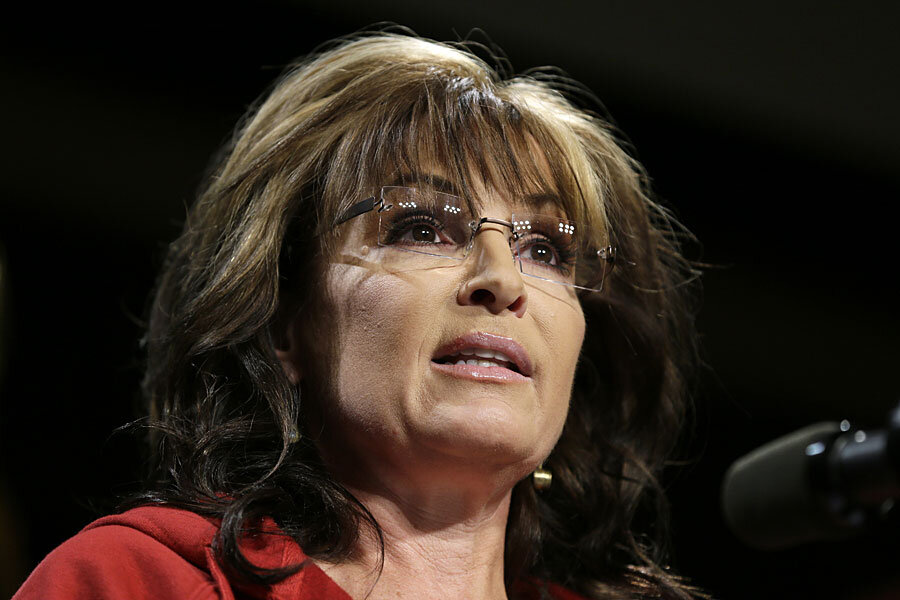On Alaska's oil tax referendum, Palin joins with liberals
Loading...
Faced with choosing between rival oil-tax plans, Alaskan voters are navigating some strange political currents.
On one side, Republican Gov. Sean Parnell and the oil industry are supporting the current flat tax on the industry. On the other side, liberal Democrats and conservative Republican Sarah Palin call the current flat tax a “giveaway” and want to return to the old sliding-scale system Ms. Palin installed as former governor.
On Tuesday, Alaskans will have to decide which tax will result in more revenue for the state. It’s a big question in a state that derives most of its budget from oil revenue – and a tricky one, because as oil production has boomed in other states, thanks to hydraulic fracturing (or fracking), it has dwindled to one-quarter of its 1988 peak in Alaska.
“Unless you have a crystal ball for what oil prices will be in the future, it’s hard to talk about which law is going to bring you more money,” says Gunnar Knapp, director of the Institute of Social and Economic Research at the University of Alaska Anchorage.
If oil prices are low, Governor Parnell’s 35 percent flat tax will rake in more money, since Palin’s scheme taxes as low as 25 percent, Mr. Knapp notes in a telephone interview Monday. If prices are high, Alaska could benefit from higher revenues with Palin’s sliding-scale tax. Known as ACES, or Alaska’s Clear and Equitable Share, her system taxed up to 75 percent, with higher rates as oil prices rose.
With increased competition from other oil-producing states, Alaska Republicans hoped the flat tax would jump-start renewed oil development in the state. But even with last year’s tax breaks, Alaska, once the nation’s top oil producer, is now No. 4 behind Texas, North Dakota, and California.
“Will our children and grandchildren inherit a state full of jobs and opportunity? Or are we going to go back to the unsustainable path of decline that we were on? That’s what this is really about,” Parnell said in an interview with The New York Times. Parnell was Palin’s lieutenant governor, and he succeeded her when she stepped down in 2009.
Last week Sarah Palin blasted the flat tax and called for its repeal in Tuesday’s referendum.
“We won’t be suckered again by multi-million dollar PR campaigns and crony capitalists,” Palin wrote on her Facebook page last week. And in an 18-minute video on the Sarah Palin Channel, Palin told Alaskan voters that “oil is our product – we have every right … to demand a clear and equitable share of our oil’s value.”
But the debate is less clear-cut than either side portrays, according to Knapp, and “both sides are arguing on the basis of very limited experience with the new law.”
The new system has been in place for only a year, so had had little time to show benefits.
Also, even with the cuts, Alaska still has among the nation’s highest tax rates on the oil industry, says Barry Rabe, a professor of public policy at the University of Michigan, in a telephone interview. “Rates are far higher than any other state has ever tried.”
Residents receive a dividend from the oil revenue the state collects. In its relationship to oil development, Mr. Rabe adds, “Alaska has really functioned more like a foreign country.”
The issue is so politically fraught in Alaska that some are steering clear of it altogether.
So far Sen. Mark Begich (D) of Alaska – facing tough reelection prospects – has declined to take a position publicly, leaving the decision to voters. Staying out of the fray in the short term may be a safe bet, but analysts say his silence may not play well in the long term.
“It doesn’t look good that he takes a pass on a huge issue,” Jennifer Duffy, senior editor for The Cook Political Report, told Politico last week. “It makes him look like a politician. … And he’s trying to run as something other than that.”
Tuesday’s elections will also determine Senator Begich’s Republican challenger for November’s midterm elections.







